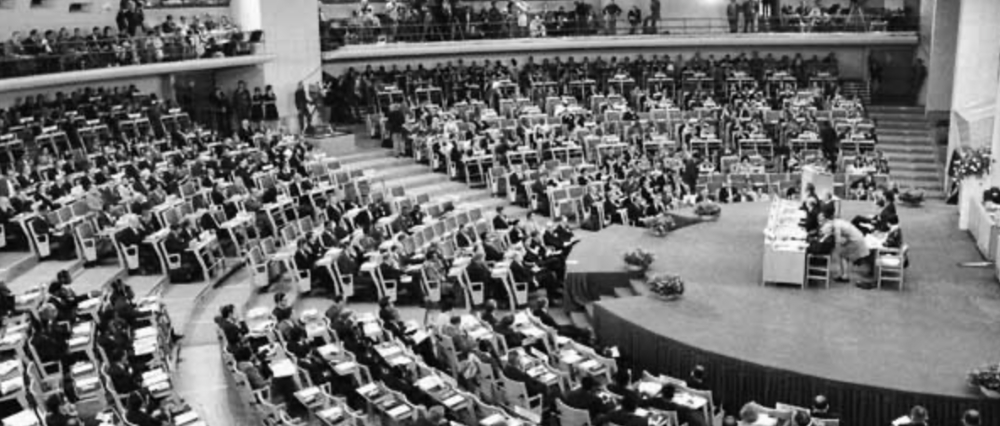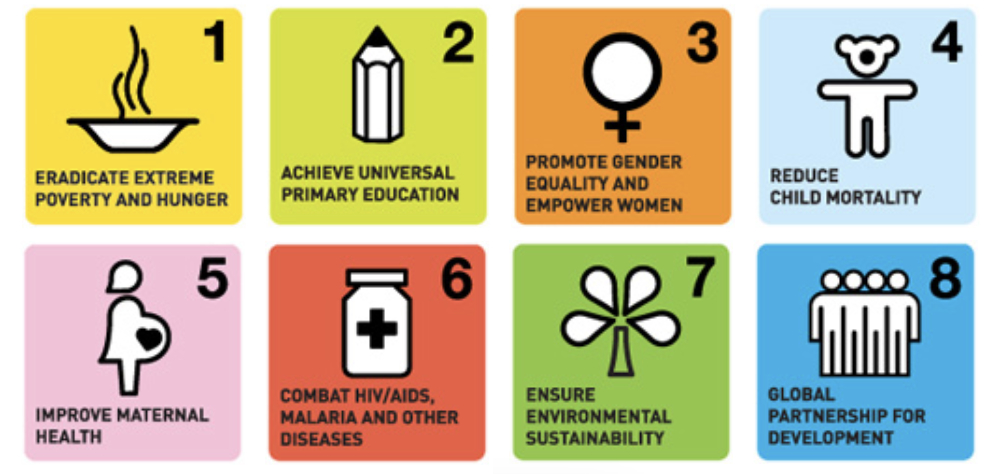Sustainable development global goals, history in progress
Contents |
[edit] Global agendas, a background
[edit] The first global set of principles
The first Earth Day was launched in April 1970. Some say this was a response to the first images of planet Earth that were published following the moon landing the year before. Two years later, and with publications such as Limits to Growth (D. Meadows and J.R. Williams (1972) pointing towards the potential of environmental and economic collapse through business-as-usual scenarios, the UN conference on the human environment was held in Stockholm. This international event led to what are considered as the first global set of principles for future international cooperation on environmental issues and the establishment of the United Nations Environment Programme (UNEP). The global principles for the human environment became known as the 26 principles of the Stockholm Declaration, and were the precursors and precedents to many other global agreements that followed.
Just one year later, in October 1973, the first oil crisis, spurred by the Fourth Middle East War, caused oil prices to rise and had the knock-on effect of dramatic inflation. This in turn increased interest in the nature of limited resources, alternatives, better management, and new economic models. with individuals and organisations establishing specialisations in the field of environmental impact as it gradually moved up the international agenda.
[edit] The Brundtland Commission
More than a decade after the UN Stockholm conference and its principles for a future environment, it was highlighted that very few issues around the environment had actually been addressed. In 1983, the World Commission on Environment and Development was established by the UN Council, better known as the Brundtland Commission after its chairperson, the former Prime Minister of Norway, Gro Harlem Brundtland.
The aim was to unite countries in the pursuit of sustainable development, having also developed the most commonly used definition of sustainable development. The brief included proposing new cooperation models to break away from the existing patterns of development, to influence policy, raise awareness, understanding, and "commitment to action on the part of individuals, voluntary organisations, businesses, institutes, and governments.”.
The Brundtland Report, 'Our Common Future', was published in 1987 and catalogued, analysed, and synthesised written submissions and expert testimony from senior government representatives, scientists and experts, research institutes, industrialists, representatives of non-governmental organisations, and the general public. It highlighted the conflict between globalised economic growth and the acceleration of ecological degradation and redefined the notion of economic development with that of sustainable development, which it defined as "development that meets the needs of the present without compromising the ability of future generations to meet their own needs."
One year later, in 1988, the Intergovernmental Panel on Climate Change (IPCC) was established by the United Nations Environment Programme (UNEP) and the World Meteorological Organisation (WMO). Its role was to provide policymakers, institutions, and the public with regular scientific assessments of the current state of knowledge about climate change. Its first task was to prepare a comprehensive review and recommendations with respect to the state of knowledge of the science of climate change, the social and economic impact of climate change, and potential response strategies and elements for inclusion in a possible future international convention on climate.
[edit] The Earth Summit
In 1992, the United Nations Conference on Environment and Development (UNCED), or the Earth Summit, was held in Rio de Janeiro. The Rio Summit was created as a platform for sustainability to be discussed beyond the reach of member states and, in particular, to cooperate internationally on development issues after the Cold War. The outcomes of the event were the 27 principles of the Rio Declaration (a follow-up from the 26 principles of the Stockholm Declaration), the United Nations Framework Convention on Climate Change (UNFCCC), the Convention on Biological Diversity, and the Declaration on the Principles of Forestry Management. It also highlighted the role of local communities and local governments in the causes and solutions of environmental issues, which was formalised in Local Agenda 21, Chapter 28 of Agenda 21, adopted by 178 governments at the time.
The Local Agenda 21 is conceptualised in Chapter 28 of Agenda 21, which recognises that many environmental problems can be traced back to local communities and that local governments have an important role to play in implementing environmental programmes and gathering community support. The objectives of Agenda 21 (including the local element) were quite specific and included:
- Local authorities in each country should be encouraged to implement and monitor programmes that aim to ensure women and youth are represented in decision-making, planning, and implementation processes.
- International community to initiate processes to increase cooperation between local authorities by 1993.
- Representatives of associations of cities and other local authorities were to have increased cooperation and coordination to enhance the exchange of information and experience among local authorities by 1994.
- Local authorities in each country must have undertaken a consultative process with their populations and achieved a consensus on "a local Agenda 21" for the community by 1996.
[edit] The Millennium Goals and agenda 2015
In September 2000, at the Millennium Summit in New York, the United Nations Millennium Declaration was signed by 189 countries. It identified fundamental values essential to international relations, set targets for realising those values around the world by 2015, and served as the focus for UN work throughout that period. A period increasingly described as the Anthropocene (originally coined in the 1980s) to replace the term Holocene, popularised by atmospheric chemist Paul J Crutzen and diatom researcher Eugene F Stoermer as the current and new geological epoch.
This new global framework for commitment; the Millennium Development Goals (MDGs) was designed to create agreement to globally combat to eight specific issues facing the population of the earth :
- Eradicate extreme poverty and hunger
- Achieve universal primary education
- Promote gender equality and empower women
- Reduce child mortality
- Improve maternal health
- Combat HIV/AIDS, malaria and other diseases
- Ensure environmental sustainability
- Global partnership for development
[edit] World Summit on Sustainable Development.
In 2002, 10 years after the first Earth Summit in Rio de Janeiro, 65,000 delegates from over 185 countries convened in South Africa for the World Summit on Sustainable Development. Issues discussed included measures to cut poverty, improve sanitation, improve ecosystems, reduce pollution, and improve energy supply for poor people. The event was significant in that the US didn't attend and was an early indication of a change of political power, which eventually led the country to effectively pull out of the Kyoto Protocol as they didn't ever ratify the agreement.
In 2004, both Russia and Canada ratified the Kyoto agreement, thus signing up to reductions in the first phase up until 2012 (though Canada became the first country to later pull out after ratification). By 2006, the emissions of China (despite ratification) had surpassed those of the US by 8%, at the same time as Al Gore, the previous US Vice President, released his climate change documentary 'An Inconvenient Truth'. Climate COPS were held yearly, though from the first in the Hague they ended with what many considered a failure to build on previous agreements in Copenhagen, amid what was known as the climate-gate scandal.
[edit] Rio +20
The United Nations Conference on Sustainable Development took place in Rio in 2012, also known as the Rio+20, as it marked twenty years after the original Earth summit in the same location. The event resulted in a focused political outcome document that contained clear and practical measures for implementing sustainable development. It was here that the member states decided to launch a process to develop a set of Sustainable Development Goals (SDGs), which will build upon the Millennium Development Goals and converge with the post-2015 development agenda, leading to the 2030 agenda.
The conference also adopted ground-breaking guidelines on green economy policies. Governments also decided to establish an intergovernmental process under the General Assembly to prepare options on a strategy for sustainable development financing. Governments also agreed to strengthen the United Nations Environment Programme (UNEP) on several fronts, with action to be taken during the 67th session of the General Assembly.
[edit] The Millennium Development Goals Report 2015
In June of 2015 the final report of the Millennium Development Goals was published. The report highlighted the number of success stories coming from the MDG programme, including ending extreme poverty for more than one billion people. The report highlighted the achievements in access to drinking water, universal primary education, child and maternal health, gender equality and eliminating hunger, among others. However, the report also underscored the need for more work as part of the post-2015 development agenda and the proposed Sustainable Development Goals (SDGs) to ensure that the poorest and most vulnerable people are not left behind.
[edit] The 2030 Agenda for Sustainable Development
In the September of 2015 the 17 Sustainable Development Goals (SDGs) of the 2030 Agenda for Sustainable Development were adopted by world leaders at the an historic UN Summit. “Transforming Our World: The 2030 Agenda for Sustainable Development,” was agreed upon by the 193 Member States of the United Nations, and included 17 Sustainable Development Goals (SDGs), officially coming into force from January 2016. The goals and the targets were designed to follow on from the Millennium goals, ending in 2015, expanding and extending these to the target date of 2030.
[edit] The Paris Agreement
COP21 was also held in Paris in 2015, following the yearly COP events, it represented a point where countries responsible for 98% of global emissions signed a legally binding agreement ( The Paris Agreement) to reduce emissions and work together on climate adaptation; these included the US, Canada, and China. The agreement was essentially contracted at the governance level to keep global warming to no more than 1.5°C, meaning global emissions needed to peak before 2025 at the latest and the decline 43% by 2030 in order to reach net zero by 2050, hence the significance of the 2030 milestone.
[edit] Measuring the SDGs
In 2017 the global indicator framework for Sustainable Development Goals was developed by the Inter-Agency and Expert Group on SDG Indicators (IAEG-SDGs) and agreed upon at the 48th session of the United Nations Statistical Commission.
The global indicator framework includes 231 unique indicators, with the total number of indicators listed in the global indicator framework of SDG indicators being 248. as thirteen indicators repeat under two or three different targets.
The global indicator framework was finally adopted by the General Assembly on 6 July 2017 and is contained in the Resolution adopted by the General Assembly on Work of the Statistical Commission pertaining to the 2030 Agenda for Sustainable Development (A/RES/71/313). According to the Resolution, the indicator framework will be refined annually and reviewed comprehensively by the Statistical Commission at its fifty-first session in March 2020 and its fifty-sixth session, to be held in 2025. The global indicator framework will be complemented by indicators at the regional and national levels, which will be developed by Member States.
[edit] SDG progress, 5 years to 2030
2025 will be the 10-year anniversary of the launch of the SDGs, leaving a 5-year period until the targets and goals set by the initial agreement are intended to be met. The UN has released year-on-year progress reports, which can be found below. The most recent of these included a warning:
'According to the report, the impacts of the climate crisis, the war in Ukraine, a weak global economy, and the lingering effects of the COVID-19 pandemic have revealed weaknesses and hindered progress towards the Goals. The report further warns that while lack of progress is universal, it is the world’s poorest and most vulnerable who are experiencing the worst effects of these unprecedented global challenges. It also points out areas that need urgent action to rescue the SDGs and deliver meaningful progress for people and the planet by 2030.'
The stark warning was summarised by António Guterres, Secretary-General, United Nations, simply saying:
"Unless we act now, the 2030 Agenda will become an epitaph for a world that might have been."
The SDG Tracker presents data across all available indicators from the Our World in Data database, using official statistics from the UN and other international organisations. It is a free, open-access information site that tracks global progress towards the SDGs and allows people worldwide to hold their governments accountable for achieving the agreed-upon goals. For more information and to study progress, visit:
SDG Tracker: Measuring progress towards the Sustainable Development Goals
- The Sustainable Development Goals Report 2023: Special Edition
- The Sustainable Development Goals Report 2022: Special Edition
- The Sustainable Development Goals Report 2021: Special Edition
- The Sustainable Development Goals Report 2020: Special Edition
- The Sustainable Development Goals Report 2019: Special Edition
- The Sustainable Development Goals Report 2018: Special Edition
- The Sustainable Development Goals Report 2017: Special Edition
- The Sustainable Development Goals Report 2016: Special Edition
[edit] Related articles on Designing Buildings
- Brundtland report.
- Climate Change Act.
- Culture: Urban Future.
- Earth overshoot day.
- Helping achieve the UN's Sustainable Development Goals.
- How gamification can help achieve the UN's SDGs.
- ICE launches engineering route map to deliver UN SDGs.
- Intergovernmental Panel on Climate Change.
- Jeffrey D. Sachs: Why we need to invest for sustainable development.
- Kyoto protocol.
- Montreal protocol.
- Planning for sustainable historic places.
- Reconciling conservation and sustainable development.
- Sustainability.
- Sustainable communities.
- Sustainable development.
- Sustainable materials.
- Sustainable procurement.
- The Carbon Plan: Delivering our low carbon future.
- The Low Carbon Transition Plan: National strategy for climate and energy.
- The sustainability of construction works
- UK Climate Change Risk Assessment.
- Jeffrey D. Sachs: Why we need to invest for sustainable development.
[edit] External links
Featured articles and news
Gregor Harvie argues that AI is state-sanctioned theft of IP.
Preserving, waterproofing and decorating buildings.
Many resources for visitors aswell as new features for members.
Using technology to empower communities
The Community data platform; capturing the DNA of a place and fostering participation, for better design.
Heat pump and wind turbine sound calculations for PDRs
MCS publish updated sound calculation standards for permitted development installations.
Homes England creates largest housing-led site in the North
Successful, 34 hectare land acquisition with the residential allocation now completed.
Scottish apprenticeship training proposals
General support although better accountability and transparency is sought.
The history of building regulations
A story of belated action in response to crisis.
Moisture, fire safety and emerging trends in living walls
How wet is your wall?
Current policy explained and newly published consultation by the UK and Welsh Governments.
British architecture 1919–39. Book review.
Conservation of listed prefabs in Moseley.
Energy industry calls for urgent reform.
Heritage staff wellbeing at work survey.
A five minute introduction.
50th Golden anniversary ECA Edmundson apprentice award
Showcasing the very best electrotechnical and engineering services for half a century.
Welsh government consults on HRBs and reg changes
Seeking feedback on a new regulatory regime and a broad range of issues.




























